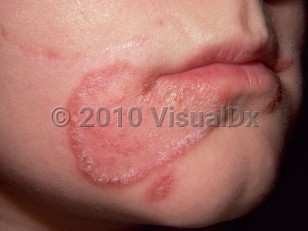Tinea faciei in Adult
See also in: External and Internal EyeAlerts and Notices
Important News & Links
Synopsis

Tinea faciei, also known as tinea faciale, is a superficial dermatophyte infection occurring in the nonbearded areas of the face. All age groups are affected, but peaks occur in children between the ages of 2 and 14 years as well as adults between 20 and 40. Different species may be anthropophilic (humans are the primary host) or zoophilic (animal host). In North America, Trichophyton tonsurans is the most common agent. In Asia, Trichophyton mentagrophytes and Trichophyton rubrum are most common. The 3 most common causative zoophilic agents worldwide are T mentagrophytes (in rodents, rabbits, dogs, and horses), Trichophyton verrucosum (in cattle), and Microsporum canis (in cats and dogs). In general, zoophilic organisms are associated with inflammatory changes while anthropophilic organisms are associated with minimal inflammation.
A severe antifungal-resistant tinea has emerged in South Asia from the rapid spread of a novel dermatophyte species: Trichophyton indotineae. Terbinafine-resistant T indotineae infections have been reported in Asia, Europe, Canada, and the United States, including one case in New York City with no history of recent international travel.
Transmission among humans is either by direct contact with those infected (animals or humans) or through fomites. Infection may also frequently arise from self-inoculation from the feet (tinea pedis), scalp (tinea capitis), or nails (tinea unguium). Tropical or humid climates are associated with more frequent and severe cases. More cases are also noted after holidays, as children may spend their holidays in rural areas where animal exposure occurs. The most common manifestation is that of one or more pruritic, erythematous, annular, scaling plaques, most often on the cheeks. Occasionally, pustules and crusting may be seen at the active edge. Untreated lesions tend to demonstrate centripetal growth over time and may become several centimeters in diameter.
In the immunocompromised patient, pruritus may be absent. There is an increased risk of all dermatophyte infections (tinea faciei, tinea pedis, tinea cruris, and tinea corporis as well as Majocchi granuloma) in immunocompromised individuals.
Related topics: tinea barbae, tinea capitis, tinea imbricata, tinea manus, tinea versicolor
A severe antifungal-resistant tinea has emerged in South Asia from the rapid spread of a novel dermatophyte species: Trichophyton indotineae. Terbinafine-resistant T indotineae infections have been reported in Asia, Europe, Canada, and the United States, including one case in New York City with no history of recent international travel.
Transmission among humans is either by direct contact with those infected (animals or humans) or through fomites. Infection may also frequently arise from self-inoculation from the feet (tinea pedis), scalp (tinea capitis), or nails (tinea unguium). Tropical or humid climates are associated with more frequent and severe cases. More cases are also noted after holidays, as children may spend their holidays in rural areas where animal exposure occurs. The most common manifestation is that of one or more pruritic, erythematous, annular, scaling plaques, most often on the cheeks. Occasionally, pustules and crusting may be seen at the active edge. Untreated lesions tend to demonstrate centripetal growth over time and may become several centimeters in diameter.
In the immunocompromised patient, pruritus may be absent. There is an increased risk of all dermatophyte infections (tinea faciei, tinea pedis, tinea cruris, and tinea corporis as well as Majocchi granuloma) in immunocompromised individuals.
Related topics: tinea barbae, tinea capitis, tinea imbricata, tinea manus, tinea versicolor
Codes
ICD10CM:
B35.8 – Other dermatophytoses
SNOMEDCT:
240696004 – Tinea faciei
B35.8 – Other dermatophytoses
SNOMEDCT:
240696004 – Tinea faciei
Look For
Subscription Required
Diagnostic Pearls
Subscription Required
Differential Diagnosis & Pitfalls

To perform a comparison, select diagnoses from the classic differential
Subscription Required
Best Tests
Subscription Required
Management Pearls
Subscription Required
Therapy
Subscription Required
References
Subscription Required
Last Reviewed:06/20/2018
Last Updated:03/17/2024
Last Updated:03/17/2024
 Patient Information for Tinea faciei in Adult
Patient Information for Tinea faciei in Adult
Premium Feature
VisualDx Patient Handouts
Available in the Elite package
- Improve treatment compliance
- Reduce after-hours questions
- Increase patient engagement and satisfaction
- Written in clear, easy-to-understand language. No confusing jargon.
- Available in English and Spanish
- Print out or email directly to your patient
Upgrade Today

Tinea faciei in Adult
See also in: External and Internal Eye

